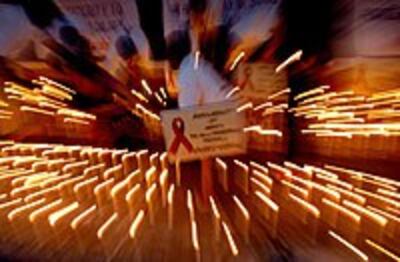
WASHINGTON -- The northwestern Muslim region of Xinjiang has become a hot spot for the spread of HIV/AIDS in China, second only to Yunnan Province near the infamous Golden Triangle drug-producing region, RFA’s Uyghur service reports.
"In Ghulja, 12,000 people are being examined by us, and about 3,000 of them are infected by HIV."a Uyghur healthcare worker in a clinic in the region told RFA. "We use Australian aid money to carry out public education about AIDS."
New infections on the rise
According to statistics published by Chinese health organizations, the number of new infections by HIV/AIDS in the Uyghur homeland region has now reached 1,000 a year. But healthcare workers in the region say the numbers could be far higher.
All 124 communities of the city's Tianshan District will be equipped with condom vending machines.
Chinese officials were anxious to highlight their jointly funded AIDS prevention program on the eve of World AIDS Day on Dec. 1. "All 124 communities of the city's Tianshan District will be equipped with condom vending machines," Urumqi family planning official Lin Quanyi was quoted as saying by the official Xinhua news agency. "This is the first part of a Sino-Australian anti-HIV program in Xinjiang."
The local government has already invested 850,000 yuan (U.S.$100,000) in the two-year program, which aims to learn from overseas health campaigns to promote condom use in Xinjiang, where around 95 percent of women of childbearing age are thought to have unprotected intercourse with their partners.
Many drug users infected
Government figures for the end of 2003 show a total of 8,150 patients infected by the HIV virus, with 180 showing the symptoms of full-blown AIDS.
Around 98 percent of the patients infected were drug users, a social group which can include children as young as eight. Even more worryingly, an increasing number of patients became infected after receiving treatment in public health facilities, sources told RFA.
The percentage of women patients has also risen sharply from one in seven in 2001 to one in three patients in 2003. Infections are also on the rise among the migrant worker population in Xinjiang.
A recent study by the Chinese health authorities in the region found drug users widely spread throughout the local counties, cities, and towns in the Uyghur region. Aside from drug usage, and sexual relations, public health facilities appear to have played a significant role in spreading infection.
Most Uyghurs unaware of dangers
It also found a higher incidence of same-sex relationships had contributed to the fast spread of the HIV/AIDS virus in the region. Further factors included lack of understanding of HIV/AIDS in the general population, an overall low level of education in the region, and hostile views towards HIV/AIDS patients and insufficient public health work and infrastructure.
The study also found that the majority of Uyghurs were unaware of high infection rates within their own community and lacked access to information on how to prevent the spread of HIV/AIDS.
We use Australian aid money to carry out public education about AIDS.
Official figures put the total number of Chinese infected with HIV/AIDS at around one million, although only a small percentage of these cases is reported.
Xinjiang was taken over by the Communist regime in 1949 after a brief period as independent East Turkestan. It is the scene of continued unrest and anti-Beijing feeling, and pro-independence activists are routinely harassed and jailed. China has ridden on the momentum of the Bush administration’s "war on terror" to justify its crackdown on the independence movement, which it alleges has connections with Osama Bin Laden.
Beijing has also launched a massive development initiative in the poorer western regions of the country in recent years, while at the same time actively encouraging the migration of Han Chinese to the troubled region. The proportion of Han Chinese in Xinjiang has grown from around 6 percent in 1949 to almost 50 percent today.
